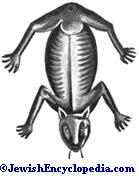ACHERON, or ACHERUSIAN LAKE:
By: Kaufmann Kohler
The fiery river of Hades in Greek mythology, mentioned in Plato's "Phædo," 113

In the Christian Apocalypse of Paul (written after some Jewish model), Paul is shown a river with waters white as milk, and told that it is the Acherusian Lake (the Syrian version has changed it into the Sea of the Eucharist), within which there was the city of God. Into this lake those who repent of their sins are cast by Michael the archangel, after which they are brought by him into the city of God, where the righteous dwell (see Apoc. Paul, ed. Tischendorf, iii. 22). The Acherusian Lake is probably the same as the nehar di-nur, the river of fire (Enoch, xvii. 5), in which the souls must bathe, according to Jellinek's "B. H." iii. 31 and 139, v. 183, to receive their baptism of purification before entering paradise, but at times they bathe in streams of balsam ("B. H." ii. 29).
- Roscher, Reallexikon der Vergleichenden Mythologie, s. v.;
- Dieterich, Nekyia, pp. 218 et seq.;
- S. Beer on passage of Enoch and Fuchs on Apoc. Mosis, xxxvii. in Kautzsch, Die Apokryphen und Pseudepigraphen des A. T. pp. 248, 525.
